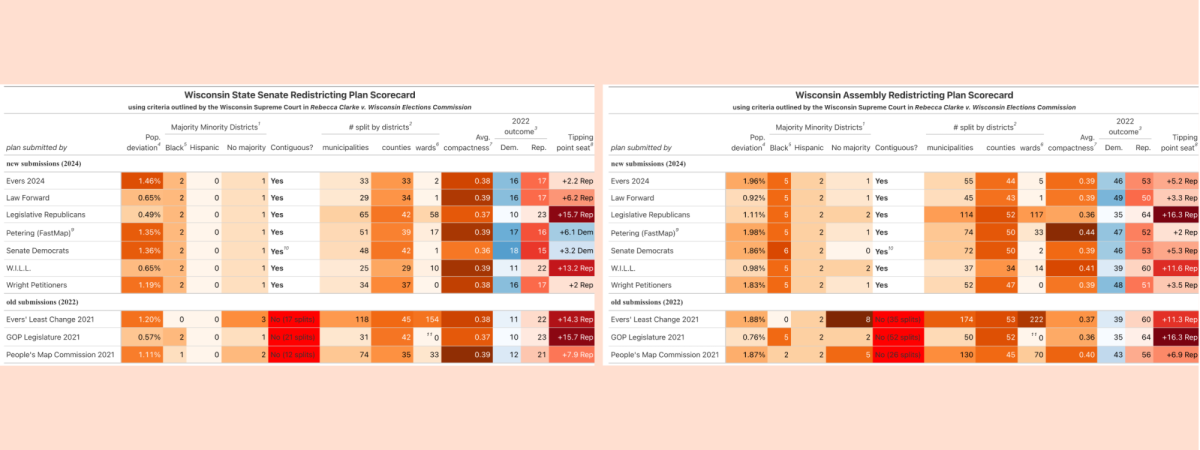In August 2023, Democrats rejoiced as Justice Janet Protasiewicz was sworn in as an Associate Justice on the Supreme Court of Wisconsin (SCOWI). With her addition, the majority ideology flipped from conservative to liberal for the first time in two decades. This new liberal majority ordered the republican state legislature to redraw their legislative maps, redrawing legislative maps is a process that normally takes place by the legislature every ten years to accommodate population changes. The purpose of redistricting is to ensure all state lawmakers represent a proportionate percentage of the electorate.
In early December, SCOWI ruled in Clarke v. Wisconsin Elections Commission that the current legislative maps, used in the 2022 election, were unconstitutional because the maps districts aren’t contiguous, meaning different parts of the districts were not connected, or shared no borders.
Justice Jill Krofsky wrote in the majority opinion, “Because the current state legislative districts contain separate, detached territory and therefore violate the constitution’s contiguity requirements, we enjoin the Wisconsin Elections Commission from using the current legislative maps in future elections.”
The court’s decision received harsh backlash from conservative activists, lawmakers, and the court’s current conservative minority. Chief Justice Anette Ziegler wrote a dissent accusing the liberal majority of “judicial activism on steroids.”
Ziegler accused the liberal majority of a political power grab and that they did not have constitutional authority for their actions. “Four justices remap Wisconsin even though this constitutional responsibility is to occur every ten years, after a census, by the other two branches of the government […] the four robe wearers grab power and fast-track this partisan call to remap Wisconsin,” Ziegler wrote.
The court asked different stakeholders to submit their own proposals for maps that they would consider with help from two out-of-state redistricting consultants. These consultants will analyze submitted maps and could possibly draw their own.
Currently, Republicans hold a 64-35 majority in the state assembly and a 22-11 supermajority in the state senate. Many political scientists and fair map advocates attribute these sizable majorities to GOP gerrymandering, where legislative maps are unfairly drawn to favor certain candidates or political parties.
Luscely Flores is the Co-Director of the Wisconsin Fair Maps Association. This group has been a longtime advocate for fair maps in Wisconsin and views the Supreme Court’s recent decision as a win for democracy and Wisconsinites as a whole.
Flores explains the important role the coalition has had in the journey towards fair maps. “We’re a group made up of 26 nonprofits across the state, we have a grassroot membership form from all across Wisconsin that focuses on fair maps, campaign finance, and supporting fair representation for all.”
The high court is now considering seven different maps submitted by different stakeholders, including Democrat Governor Tony Evers, the Republican Legislative Caucus, and the Wisconsin Senate Democratic Caucus. According to John D. Jonson, a Research Fellow at Marquette Law School, all seven maps would give Republicans a majority in the state assembly. The range would greatly vary however, if the court sides with legislative republicans leaders the GOP would maintain roughly a 16-seat majority. However, that majority would be just five seats under Governor Evers’ proposed map.
A different set of Evers’ maps was temporarily adopted in 2021 before being struck down by the United States Supreme Court just weeks later. In early January, Evers submitted a new setup map for consideration.
“Wisconsinites don’t want Republican or Democrat maps because Wisconsin isn’t a red or blue state—we’re a purple state, and our maps should reflect that basic fact. I’ve always promised I’d fight for fair maps—not maps that favor one political party or another—and that’s a promise I’m proud to keep with the maps I’m submitting today,” Evers said in a press release.









